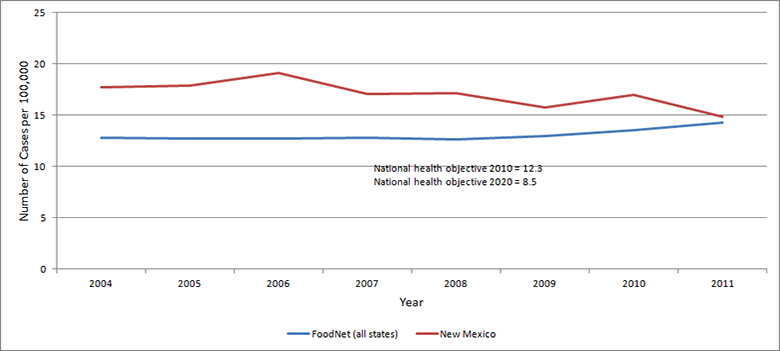Campylobacter
Campylobacter is the most common bacterial cause of diarrheal illness in the United States. People with Campylobacter infection (campylobacteriosis) usually have diarrhea, abdominal cramps, nausea, vomiting, and fever. The diarrhea can be bloody. Most patients recover in less than one week, even in the absence of antibiotic treatment; however, some people have a long illness or a recurrence of signs and symptoms. This disease is usually spread by eating contaminated water or food (especially undercooked chicken or pork), or by handling raw poultry. Infection can also result from direct contact with stool from infected pets or farm animals, and less commonly from stool of an infected person.
Campylobacter Infection in New Mexico and the United States
Active, population-based surveillance for Campylobacter has been conducted throughout New Mexico since 2004 as part of the New Mexico Emerging Infections Program (NMEIP) FoodNet system. Medical records for residents of New Mexico with Campylobacter infection are reviewed for demographic and other epidemiologic information. Through this surveillance system New Mexico FoodNet is able to examine and describe Campylobacter infections in the state. Data from New Mexico and other EIP FoodNet sites are aggregated by the Centers for Disease Control and Prevention to generate national estimates.
During 2011, there were 307 culture-confirmed cases of campylobacteriosis identified in New Mexico, a rate of 14.9 per 100,000 population. The overall 2011 national EIP rate is 14.3 per 100,000. Western EIP states appear to have higher campylobacteriosis incidence than eastern EIP states; the states west of the Mississippi River (CA, CO, MN, OR) had an average rate of 22.9 per in 2011 (excluding New Mexico), while the states east of the Mississippi (CT, GA, MD, NY, TN) had an average rate of 11.4 per 100,000 in 2011. This disparity is representative across years; it is unknown why the rate disparities occur.
In New Mexico, disease rates were highest in persons in the one to four age group (40.8/100,000). Overall, 53% of campylobacteriosis cases were male. Race data were available for 320 of the 343 cases (93%). American Indians had the highest rates of campylobacteriosis (34.0/100,000), more than double the rate for whites (14.7/100,000).
Hospitalization data were available for 304 of the 343 cases (89%). Of the 304 cases with hospitalization data, 15% (n=47) were hospitalized. These data are consistent with reported national data from EIP, which estimates Campylobacter-associated hospitalization between 8%-15%. Length of hospitalization in New Mexico cases ranged from 1 – 33 days, with 81% hospitalized for less than five days. There were no reported deaths related to Campylobacter infection in New Mexico during 2004.
Please visit the New Mexico Infectious Disease Data page for additional data.
Figure 1: Incidence of Laboratory-Confirmed Campylobacter Infections, New Mexico and All FoodNet Sites, 2004-2011

References
- Samuel MC, Vugia DJ, Shallow S, Marcus R, Segler S, McGivern T, Kassenborg H, Reilly K, Kennedy M, Angulo FJ, Tauxe RV. Epidemiology of Sporadic Campylobacter Infection in the United States and Declining Trend in Incidence, FoodNet 1996 - 1999. Clinical Infectious Diseases Supplement 2004;38:165-174.
- Centers for Disease Control and Prevention. Preliminary FoodNet Data on the Incidence of Infection With Pathogens Transmitted Commonly Through Food—10 Sites, United States, 2004. Morbidity and Mortality Weekly Report 2005;54(14):352-356.
- Hughes, RA, Rees JH. Clinical and Epidemiological Features of Guillain-Barre Syndrome. Journal of Infectious Diseases 1997;17(1):104-108.
- Allos, BM. Campylobacter jejuni Infections: Update on Emerging Issues and Trends. Clinical Infectious Diseases 2001;32(8):1201-1206.

